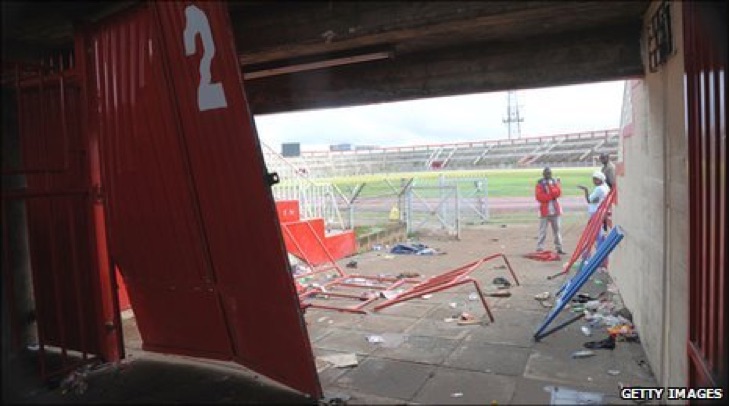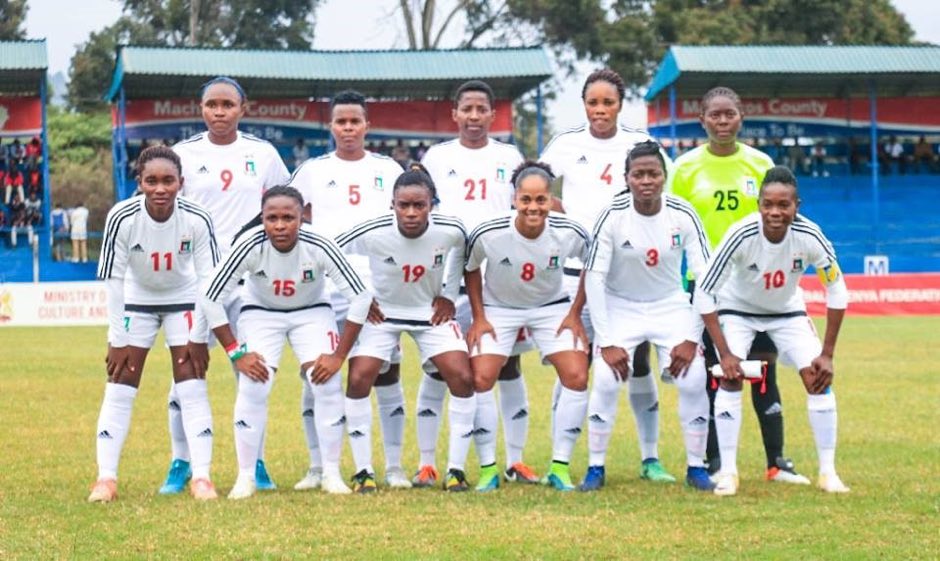For the second time in less than ten days, a stampede in a stadium in Africa turned out fatal. Fans at a soccer match in Angola tried to push through one exit channel on Saturday, causing a stampede that killed five people.
One person was critically injured and 20 others had minor injuries in the accident at Estadio 11 de Novembro Stadium in Luanda, the venue that hosted 2010 Africa Cup of Nations finals. The stadium management is said to be conducting an investigation with the help of police.
The stampede happened during a CAF Champions League quarter-final match between Desportivo 1 de Agosto and TP Mazembe as the fans rushed to exit the stadium using one gate after the game that ended in a barren draw.
Fans had filled the 50,000-seater stadium to the brim for the highly anticipated match and some could be seen hanging dangerously around the inner barrier separating the pitch and the stands.
The organizational nightmare in Africa stadiums had been highlighted a few days ago after the Madagascar-Senegal’s Africa Cup of Nations game, where one fan lost his life, but no one at FIFA or CAF seemed to listen.
Indeed, this is the second case of a stampede in an Angolan Stadium in less than two years, with the other tragedy having happened in February last year where 17 people were killed in the northern city of Uige during a local first division league match.
It’s 18 months since that tragedy and it’s now evident that the trouble with Africa is a short attention span, collective amnesia and a seeming inability to learn from past mistakes.
In 2001, in Africa’s worst disaster, 127 were killed during a stampede at the Accra Sports Stadium during a match between Accra Hearts of Oak and Asante Kotoko, while 19 were killed at the Stade Felix Houphouet-Boigny in Abidjan ahead of Cote d’Ivoire’s 2010 World Cup qualifier against Malawi.
17 years ago, in the most catastrophic sporting disaster in the history of South African football, 43 people were crushed to death at Ellis Park Stadium during a Soweto Derby between Orlando Pirates and Kaizer Chiefs, as a reported 30,000 fans attempted to pile into the 60,000 capacity stadium, which was already full to bursting.
The disaster came a decade after the Oppenheimer Stadium disaster—also in South Africa—where 42 people lost their lives during the same fixture.
Apart from CAF releasing statements on the listed incidents, nothing seems to have changed. The usual FIFA/CAF Regional Seminars for National Security Officers that were held during Issa Hayatou’s era now seem to have been forgotten and none can has been held in recent years.
It is evident that the African football governing body is not doing more to assist domestic governing bodies to improve stadium conditions and inform local authorities about how to manage major events.
The five deaths must serve to re-energize continental focus on the issue rather than the myopic and self-interest of soccer officials across the continent locked in a life-or-death combat over finances and other undisclosed vested interests that have nothing to do with improving the image of the world’s most popular sport — the “beautiful game.”
There does not seem to be internationally accepted standards employed regarding crowd control in most of the stadiums across Africa. For instance, a build-up of crowds must be avoided at all costs. If this basic tenet is not adhered to, there is the very real fear of an entire stadium collapsing.
Ticket pricing
In this case, incentives need to be extended during ticketing so that it is in the fans’ interest to come in early. One such incentive would be a live music or comic show to act as curtain raisers so that the fans’ eye is literally taken off the ball, hours to kick-off.
In this regard, more ticket sales points should be introduced and tickets sold at discounted rates. Higher ticket pricing should discourage last-minute purchases.
Similarly, personnel manning the gates must be uniformed for visibility and in sufficient numbers to handle surging crowds. In the same breath, tickets need to be gated so that there are several entry points to avoid overwhelming numbers in one or two spots.
For instance, Estadio 11 de Novembro Stadium has eight entry points. Why was there a stampede through one? What was it about that particular entry point? There is a football renaissance of sorts being witnessed in Africa and live soccer matches should no longer be treated as a mere sports affair.
With over 50,000 fans crammed in one place, it should be seen as a security issue, just like we treat events at the stadium during other events. Why are there chaotic scenes over parking? Why were there no safe passage and evacuation corridors for emergency medical and fire crews? How come there is no first-aid area or component at this stadium?
Dishonesty on the sale of tickets has been another problem and lack of new technology by CAF to member federations to curb this- why do we have to use people to cut tickets until the last minute before kick-off?
Plenty of speculation over what really happened in the recent Angola and Madagascar tie must be there and now it’s right time for CAF to join Angolan investigators to unearth the real cause of the commotion and their report will need to be competent enough to suggest ways to avoid similar situations in future.
It should be remembered that one and half years after the last Angola incident, fans are still asking questions, What really happened? Who was responsible? Could it have been avoided? Indeed football fraternity and bereaved families are still waiting for an inquest to, at least, know the truth so that justice can be served but above all to avoid such incidents in future across the beautiful continent of Africa.






